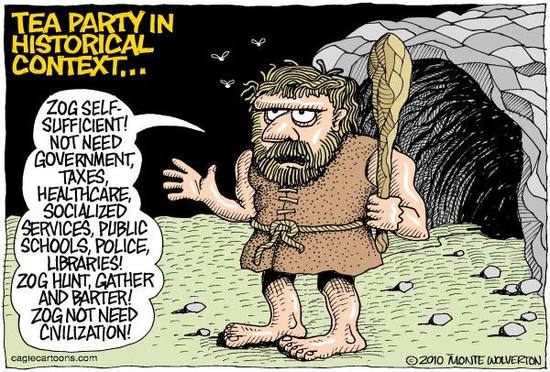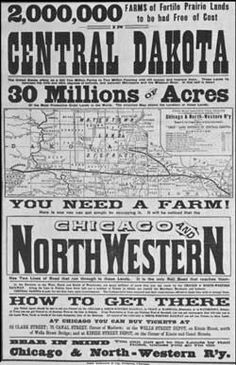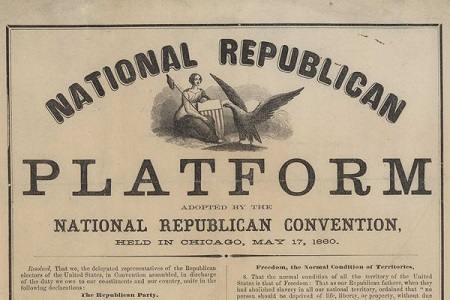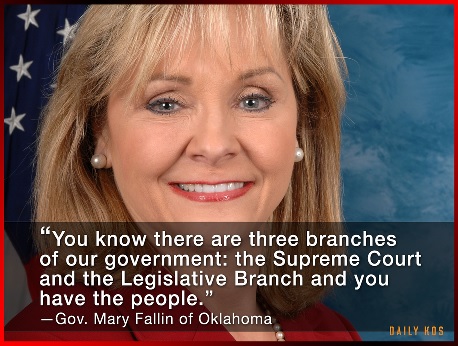
I’ve been working my way through the Oklahoma Constitution, and it’s as much work as I’d feared. We may have to fast-forward a bit so I can be finished before the elections!
You can read my Introduction in Part One and my brilliant analysis of Articles I & II in Part Two. We made it through Articles III, IV, and V in Part Three – mostly talking about the powers of the Legislature.
Time for the other two branches, and then some.
Section VI-1: Executive officers enumerated – Offices and records – Duties.
A. The Executive authority of the state shall be vested in a Governor, Lieutenant Governor, Secretary of State, State Auditor and Inspector, Attorney General, State Treasurer, Superintendent of Public Instruction, Commissioner of Labor, Commissioner of Insurance and other officers provided by law and this Constitution, each of whom shall keep his office and public records, books and papers at the seat of government, and shall perform such duties as may be designated in this Constitution or prescribed by law.
The Superintendent of Public Instruction is specifically mentioned in the very first paragraph of Article VI, the Executive Department. There are only eight other offices called out by name here, two of which are the Governor and Lieutenant Governor.
That suggests that public education is not only a potential function of state government, but an expected, demanded, prioritized function of this state’s government. It’s not charity, or governmental overreach, or some sort of New Age liberal plot to subvert the REAL values of the state. It’s one of SEVEN functions, along with things like State Treasurer and Commissioner of Labor, to be named specifically in the State Constitution as part of the Executive Branch.
We’re SUPPOSED to prioritize public education, along with those other things. It’s in our constitution, unlike many of the things people undercutting schools are prioritizing instead – often in the name of ‘fidelity’ to founding values.
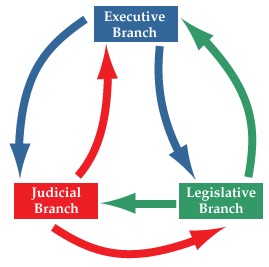 The rest of Article V is about the logistics of elections, vetoing or signing legislation, and creating a few other commissions and positions necessary to keep things running. Nothing too exciting.
The rest of Article V is about the logistics of elections, vetoing or signing legislation, and creating a few other commissions and positions necessary to keep things running. Nothing too exciting.
Articles VI & VII establish the court system and how judges are chosen. This one has changed quite a bit since the original, but none of that is particularly relevant here. So let’s move on, shall we?
Article VIII is about impeachment of state officials. Entertaining, I know, but also not what we’re looking for at the moment.
Article IX is about Corporations. It establishes a sort of ‘mandatory cooperation’ between completing railroads, pipelines, telegraph and telephone companies, etc. – things which might be considered essential public services.
There’s a real ‘love/hate’ relationship with railroads which is amusing. Article IX, Paragraph 13 prohibits railroads from giving free rides to anyone (presumably to prevent buying political or business favors this way), EXCEPT…
…its employees and their families, its officers, agents, surgeons, physicians, and attorneys at law; to ministers of religion, traveling secretaries for railroad Young Men’s Christian Associations, inmates of hospitals and charitable and eleemosynary institutions and persons exclusively engaged in charitable and eleemosynary work; to indigent, destitute and homeless persons, and to such persons when transported by charitable societies or hospitals, and the necessary agents employed in such transportations; to inmates of the National Homes, or State Homes for Disabled Volunteer Soldiers, and of Soldiers’ and Sailors’ Homes, including those about to enter and those returning home after discharge, and boards of managers of such Homes;
to members of volunteer fire departments and their equipage, while traveling as such; to necessary caretakers of livestock, poultry, and fruit; to employees of sleeping cars, of express cars, and to linemen of telegraph and telephone companies; to Railway Mail Service employees, post office inspectors, customs inspectors, and immigration inspectors;
to newsboys on trains, baggage agents, witnesses attending any legal investigation in which the railroad company or transportation company is interested, persons injured in wrecks, and physicians and nurses attending such persons… {or anyone} providing relief in cases of general epidemic, pestilence, or other calamitous visitation…
OK, this has nothing to do with public education. But it amuses me nonetheless, for at least three reasons.
1. Our state constitution has a long list specifically delineating precisely to whom railroads are allowed to give free rides. That’s messed up in ways I can’t even elucidate properly.
2. I had to look up “eleemosynary.” It means “of, relating to, or dependent on charity.” I wonder what distinguished “eleemosynary institutions” from “charitable societies” in the language of the day? It’s also interesting that we used to value taking care of people, albeit through the filter of private companies giving them free transportation. It’s at least indirectly promoted via foundational legalese.
3. I love the phrase “general epidemic, pestilence, or other calamitous visitation.” Not sure what they had in mind, but at least we’d be able to ride the train for free.
“Calamitous visitation” – *shiver* – !!!
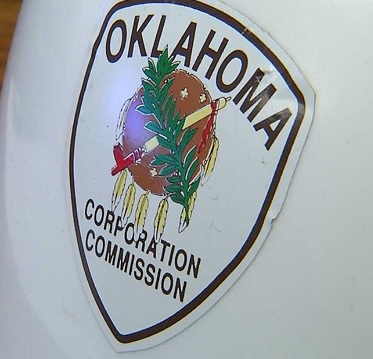 Article IX goes on to establish the state Corporation Commission, which regulates industries determined to be ‘public services’ – utilities, transportation, oil & gas, telephone, etc. When we study the Populist Party of the late 19th Century and I ask about lingering impacts, this one counts as a really good answer.
Article IX goes on to establish the state Corporation Commission, which regulates industries determined to be ‘public services’ – utilities, transportation, oil & gas, telephone, etc. When we study the Populist Party of the late 19th Century and I ask about lingering impacts, this one counts as a really good answer.
There are a lot of details here. The Commission is given substantial powers, and even its own internal court system for punishing wrongdoers.
It was a very regulate-y time, one of substantial distrust towards both government and big business. The authors of our state constitution wanted to do whatever they could to provide protection for individual citizens against money and power.
The very existence of a Corporation Commission – written not simply into law, but into Oklahoma’s freakishly detailed Constitution – strongly suggests that a primary function of state government is to regulate and supervise industry in such a way as to ensure that profits and growth are balanced by the public good.
Let me say that again.
Written into our state’s founding document are extensive guidelines seeking to ensure that big businesses don’t use their power and status to take advantage of the little people. Granted, the primary concern was that they’d overcharge for poor service, but it nevertheless runs contrary to the sort of ‘free market’ ideal we hear trotted out ’round these parts lately. In it, Adam Smith and his Eve, Ayn Rand, are tempted by the Serpent of Giving-A-Damn-About-Anyone-Other-Than-Yourself to partake of the Fruit of Socialism, from whose juices flow only sweet, sugary destruction.
But… in such a brutally laissez-faire ideal, problems like those the Corporation Commission was created to address are self-correcting. If you don’t like the conditions at the train station, don’t take the train. If you don’t like the taste of the water, don’t drink the water. Unhappy with fracking and earthquakes? Dip into your secondary 401K and spend more time at your ancestral villa in Rome.
It seems our state’s framers knew that sometimes the power of capitalism, for all its wonders, requires a balancing power looking out for the collective good. Sometimes the market which is so good at producing amazing phone options or gluten-free Oreos doesn’t do a very good job of making sure there’s nothing weird in Tonya’s gas, or that the electric company doesn’t charge more in areas which tend to have more outages due to weather. So, they tried at the foundational level to balance growth and profit and corporate freedom with the practical needs of a thriving populace.
That’s not Socialism. That’s a primary function of state government. Capitalism can flourish without morphing into unfettered Darwinism. If we can avoid creating mobs of the Factionless and Disenfranchised, it might flourish BETTER.
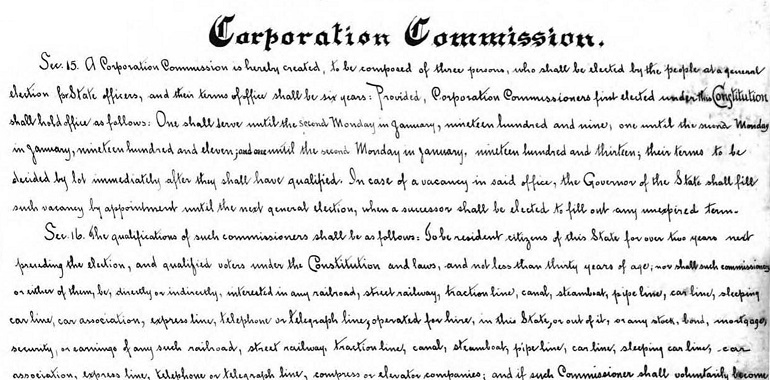
“States’ rights” isn’t about the elimination of all functions of government; states’ rights is an argument that the states can and should be doing many of those functions better than the federal government. Historically this has led to some major problems related to civil liberties, but that in no way eliminates each state’s obligation to maintain a DMV or support public schools. The current faux patriotism of ‘to hell with basic government functions’ is misguided at best, and delusional beyond measure.
There’s even a hint that government oversight and protection has room to grow:
Section IX-25: Reports and recommendations.
The Commission shall make annual reports to the Governor of its proceedings, in which reports it shall recommend, from time to time, such new or additional legislation in reference to its powers or duties, or the creation, supervision, regulation or control of corporations, or to the subject of taxation, as it may deem wise or expedient, or as may be required by law.
Growth of government as a founding Oklahoma principle. Who would have guessed?
Here’s a bit from Paragraph 34 I found interesting:
The provisions of this Article shall always be so restricted in their application as not to conflict with any of the provisions of the Constitution of the United States, and as if the necessary limitations upon their interpretation had been herein expressed in each case.
It should go without saying – whatever the subject covered in a state constitution – that subsequent supporting legislation cannot conflict with THE Constitution.
I’ll spare you my rant on THAT for the moment.
Section IX-40: Influencing elections or official duty.
No corporation organized or doing business in this State shall be permitted to influence elections or official duty by contributions of money or anything of value.
How did we NOT include out-of-state “think tanks” in this?! Oh, right – those weren’t a thing back then.
Next: Revenue & Taxation, State & School Lands, Homestead Exemptions, and – finally – Common Education. I know, right?! GET READY.

RELATED LINK: The Oklahoma Constitution (Part One)
RELATED LINK: The Oklahoma Constitution (Part Two)
RELATED LINK: The Oklahoma Constitution (Part Three)
RELATED LINK: The Blaine Game (Updated)

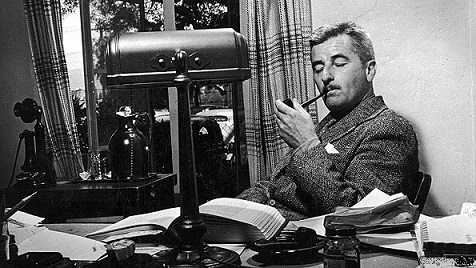
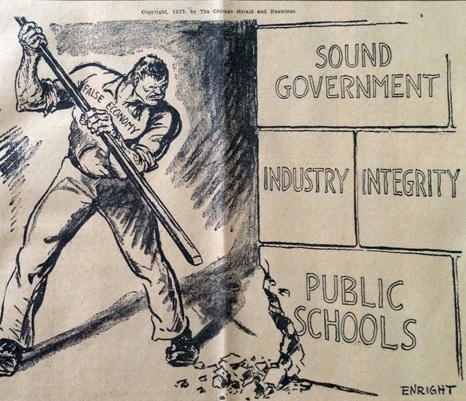 This mindset was a precursor to the Progressive Era and its Amendments – the 16th, 17th, 18th, and 19th. Basically, there was a concern that government at all levels was too far removed from ‘the people.’ Various reforms gave voters more direct input on who was elected and what changes could be made – recalls, referendums, etc.
This mindset was a precursor to the Progressive Era and its Amendments – the 16th, 17th, 18th, and 19th. Basically, there was a concern that government at all levels was too far removed from ‘the people.’ Various reforms gave voters more direct input on who was elected and what changes could be made – recalls, referendums, etc.  That’s important in a decade during which we repeatedly introduce, debate, and occasionally pass state laws which are undeniably doomed once challenged in the courts. We spend hundreds of thousands of dollars fighting for the right to return to the 19th century.
That’s important in a decade during which we repeatedly introduce, debate, and occasionally pass state laws which are undeniably doomed once challenged in the courts. We spend hundreds of thousands of dollars fighting for the right to return to the 19th century. 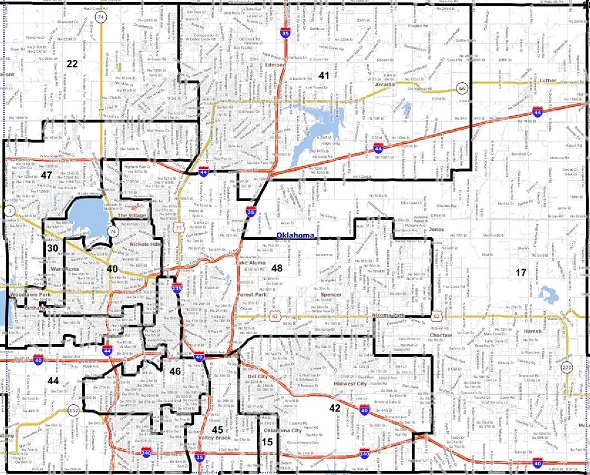
 This has caused untold grief since oil prices crashed. Due to previously passed legislation, the tax cuts for top earners across the state keep waterfalling at preplanned intervals, despite little evidence they’re producing all of that ‘prosperity’ used to justify them in the first place. When anyone suggests perhaps we could slow down on that a bit until we’re no longer feeding on the weak and the young, our legislature cries with hands upraised – “What can we do?! It’s… it’s… AGAINST THE RULES!”
This has caused untold grief since oil prices crashed. Due to previously passed legislation, the tax cuts for top earners across the state keep waterfalling at preplanned intervals, despite little evidence they’re producing all of that ‘prosperity’ used to justify them in the first place. When anyone suggests perhaps we could slow down on that a bit until we’re no longer feeding on the weak and the young, our legislature cries with hands upraised – “What can we do?! It’s… it’s… AGAINST THE RULES!” 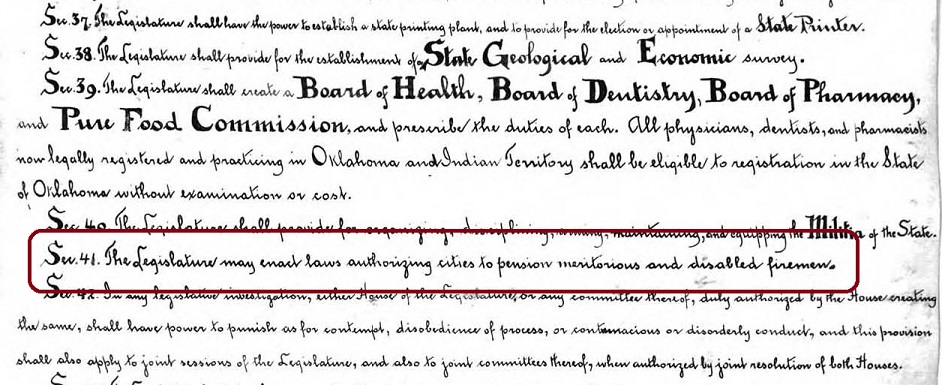
 We’d like to tweak the A-F School District Shaming System by juggling a few phrases, and ohyeahbytheway – THIS IS AN EMERGENCY AND IMMEDIATELY NECESSARY FOR THE PRESERVATION OF THE PUBLIC PEACE, HEALTH, AND SAFETY.
We’d like to tweak the A-F School District Shaming System by juggling a few phrases, and ohyeahbytheway – THIS IS AN EMERGENCY AND IMMEDIATELY NECESSARY FOR THE PRESERVATION OF THE PUBLIC PEACE, HEALTH, AND SAFETY.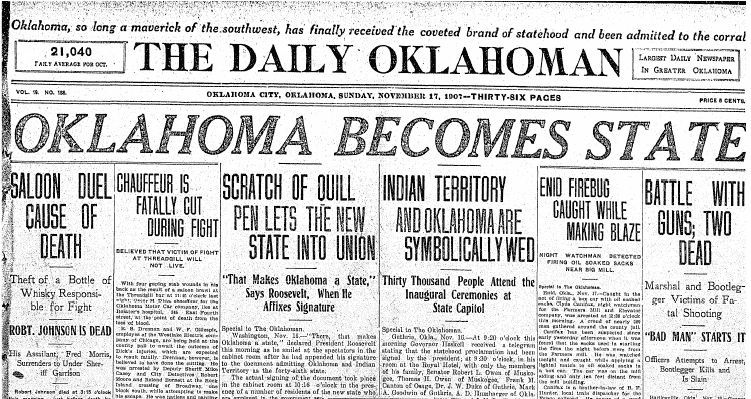
 When the Republican Party became a thing in the 1850s, it pushed two basic tenets: (1) Slavery is bad, and (2) Polygamy is bad. The second was clearly in response to the Latter Day Saints.
When the Republican Party became a thing in the 1850s, it pushed two basic tenets: (1) Slavery is bad, and (2) Polygamy is bad. The second was clearly in response to the Latter Day Saints. 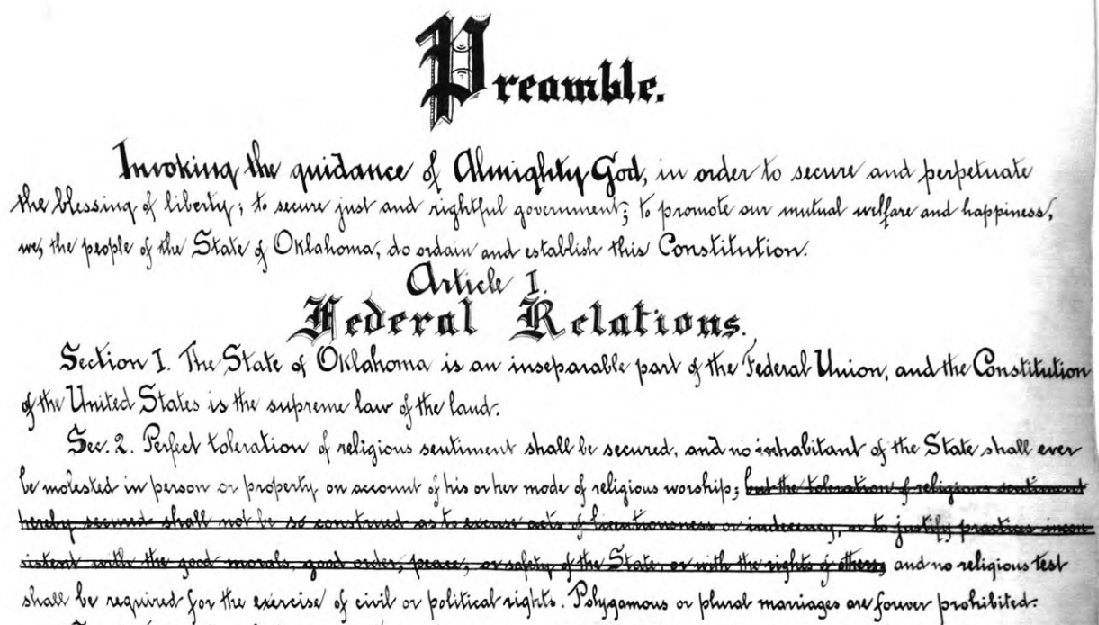
 Look at that. We DID know about the Reconstruction Amendments way back then. Wonder how we lost THAT collective awareness…
Look at that. We DID know about the Reconstruction Amendments way back then. Wonder how we lost THAT collective awareness…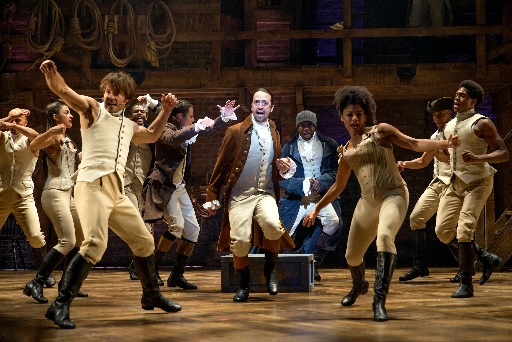 That’s perfectly consistent with American ideals. Jefferson may have changed “life, liberty, and property” to “life, liberty, and the pursuit of happiness,” but the original phrase is used often enough elsewhere to leave little doubt regarding intent.
That’s perfectly consistent with American ideals. Jefferson may have changed “life, liberty, and property” to “life, liberty, and the pursuit of happiness,” but the original phrase is used often enough elsewhere to leave little doubt regarding intent.
 The U.S. Constitution, including all 27 Amendments, takes up less than 14 pages as a Word document with normal fonts and margins. The Oklahoma Constitution, in contrast, takes 221 pages.
The U.S. Constitution, including all 27 Amendments, takes up less than 14 pages as a Word document with normal fonts and margins. The Oklahoma Constitution, in contrast, takes 221 pages. If you know anything about Alfalfa Bill, this is either painfully ironic or ridiculously amusing. Even if you don’t, the founding of Oklahoma on ‘modern thought’ and the ‘highest estimate of intelligence and progress’ should produce some sort of reaction. Perhaps even involuntary regurgitation.
If you know anything about Alfalfa Bill, this is either painfully ironic or ridiculously amusing. Even if you don’t, the founding of Oklahoma on ‘modern thought’ and the ‘highest estimate of intelligence and progress’ should produce some sort of reaction. Perhaps even involuntary regurgitation.  In 1906, the U.S. Congress passed the “Oklahoma Enabling Act,” providing for a single state to be formed from Oklahoma and Indian Territories. Each half sent delegates – mostly Democrats – and William H. Murray was – big shocker here – elected president of this new Constitutional Convention.
In 1906, the U.S. Congress passed the “Oklahoma Enabling Act,” providing for a single state to be formed from Oklahoma and Indian Territories. Each half sent delegates – mostly Democrats – and William H. Murray was – big shocker here – elected president of this new Constitutional Convention. 
 Early in the document (Article II), the drafters enumerated thirty-three rights in the Bill of Rights Article. This was followed by the article on suffrage. The right to vote, except in school board elections, was restricted to males. (The constitution was amended giving women the right to vote in 1918, two years before the U.S. Constitution was amended giving women the right to vote.)
Early in the document (Article II), the drafters enumerated thirty-three rights in the Bill of Rights Article. This was followed by the article on suffrage. The right to vote, except in school board elections, was restricted to males. (The constitution was amended giving women the right to vote in 1918, two years before the U.S. Constitution was amended giving women the right to vote.)  That thing where so many positions are elected rather than appointed is creating headaches even today. It was an age of ‘let the people decide’, creating rules not conducive to our love of ‘voting the party ticket’ for everything from Governor to Dog Catcher to Insurance Commissioner.
That thing where so many positions are elected rather than appointed is creating headaches even today. It was an age of ‘let the people decide’, creating rules not conducive to our love of ‘voting the party ticket’ for everything from Governor to Dog Catcher to Insurance Commissioner. 
 That last part is what’s been so-often cited to explain why we simply CAN’T slow down the almost complete elimination of taxes for anyone wearing expensive suits and smoking cigars in darkened back rooms. Once the process is begun, the argument goes, any reduction of the destruction amounts to a ‘tax increase’.
That last part is what’s been so-often cited to explain why we simply CAN’T slow down the almost complete elimination of taxes for anyone wearing expensive suits and smoking cigars in darkened back rooms. Once the process is begun, the argument goes, any reduction of the destruction amounts to a ‘tax increase’. William Jennings Bryan told the members of the Oklahoma Constitutional Convention that they had borrowed the best provisions of the existing state and national constitutions and had, in the process, created the best constitution ever written. Scholars who believe that brief constitutions devoid of policy make the best constitutions would disagree with Bryan’s assessment.
William Jennings Bryan told the members of the Oklahoma Constitutional Convention that they had borrowed the best provisions of the existing state and national constitutions and had, in the process, created the best constitution ever written. Scholars who believe that brief constitutions devoid of policy make the best constitutions would disagree with Bryan’s assessment.




